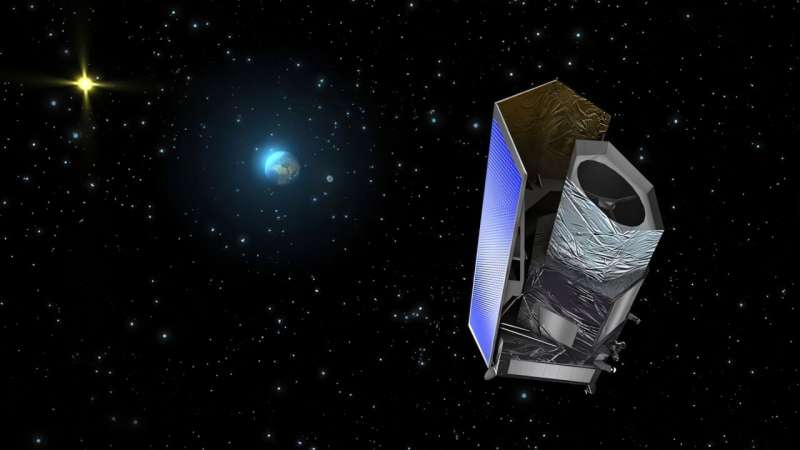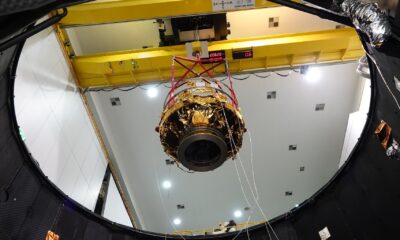Science
Euclid Space Telescope Could Extend Mission for Groundbreaking Science

The European Space Agency’s (ESA) Euclid space telescope may have the potential for an extended mission lasting an additional eight years. According to a recent study by scientist Luigi “Rolly” Bedin from the Astronomical Institute of Padua, this extension could transform Euclid into the most powerful astrometric telescope ever developed.
Scheduled to conclude its primary mission in 2030, Euclid is currently tasked with mapping the elusive realms of dark energy and dark matter. The craft, which has additional fuel reserves, could effectively double its original mission duration of six years, providing a unique opportunity to gather more data on celestial movements.
Bedin’s proposal suggests that during this extended period, Euclid should replicate the observations made during its initial mission. This approach may initially seem redundant, but obtaining a second data point would allow astronomers to calculate the “proper motion” of nearby stars against the backdrop of more distant galaxies. Proper motion is vital for understanding the dynamics of our galaxy, as it measures how closer objects shift over time.
While some may point out that the Gaia mission is already conducting similar work, Bedin emphasizes a significant difference. Gaia, designed to create a three-dimensional map of the Milky Way, has limitations on the faintness of objects it can detect. In contrast, Euclid possesses the capability to observe objects significantly fainter—up to six magnitudes more than Gaia—allowing for the discovery of billions of additional celestial sources.
As the missions of both telescopes overlap, Gaia’s datasets assist Euclid in calibrating its observations. This collaboration could enhance the accuracy of measurements for objects already identified by Gaia by a factor of ten. Nevertheless, Bedin argues that Euclid’s potential extends beyond just complementing Gaia’s findings.
He proposes a novel idea for utilizing Euclid’s remaining fuel: conducting a third set of observations aimed at measuring “parallax.” This technique involves capturing images of specific stars six months apart, leveraging the telescope’s position on opposite sides of the sun. Such observations would enhance distance estimations of these stars, akin to how human depth perception operates.
Bedin acknowledges that several engineering challenges exist for this advanced method, as Euclid was not originally designed for parallax measurements. However, he believes these challenges are manageable. He asserts that merely repeating the initial observational campaign to gather data on proper motion presents no major obstacles.
With ample time remaining in Euclid’s primary mission, project managers at ESA should seriously consider Bedin’s recommendations. His ideas represent a pragmatic and innovative use of resources that could yield significant scientific discoveries.
More information on this proposal can be found in Bedin’s paper, titled “The case for an Astrometric Mission Extension of Euclid,” available on the arXiv preprint server.
-

 Technology5 months ago
Technology5 months agoDiscover the Top 10 Calorie Counting Apps of 2025
-

 Health2 months ago
Health2 months agoBella Hadid Shares Health Update After Treatment for Lyme Disease
-

 Health3 months ago
Health3 months agoErin Bates Shares Recovery Update Following Sepsis Complications
-

 Technology4 months ago
Technology4 months agoDiscover How to Reverse Image Search Using ChatGPT Effortlessly
-

 Technology1 month ago
Technology1 month agoDiscover 2025’s Top GPUs for Exceptional 4K Gaming Performance
-

 Technology2 months ago
Technology2 months agoElectric Moto Influencer Surronster Arrested in Tijuana
-

 Technology5 months ago
Technology5 months agoMeta Initiates $60B AI Data Center Expansion, Starting in Ohio
-

 Technology5 months ago
Technology5 months agoRecovering a Suspended TikTok Account: A Step-by-Step Guide
-

 Health4 months ago
Health4 months agoTested: Rab Firewall Mountain Jacket Survives Harsh Conditions
-

 Lifestyle5 months ago
Lifestyle5 months agoBelton Family Reunites After Daughter Survives Hill Country Floods
-

 Technology4 months ago
Technology4 months agoHarmonic Launches AI Chatbot App to Transform Mathematical Reasoning
-

 Technology3 months ago
Technology3 months agoUncovering the Top Five Most Challenging Motorcycles to Ride




















